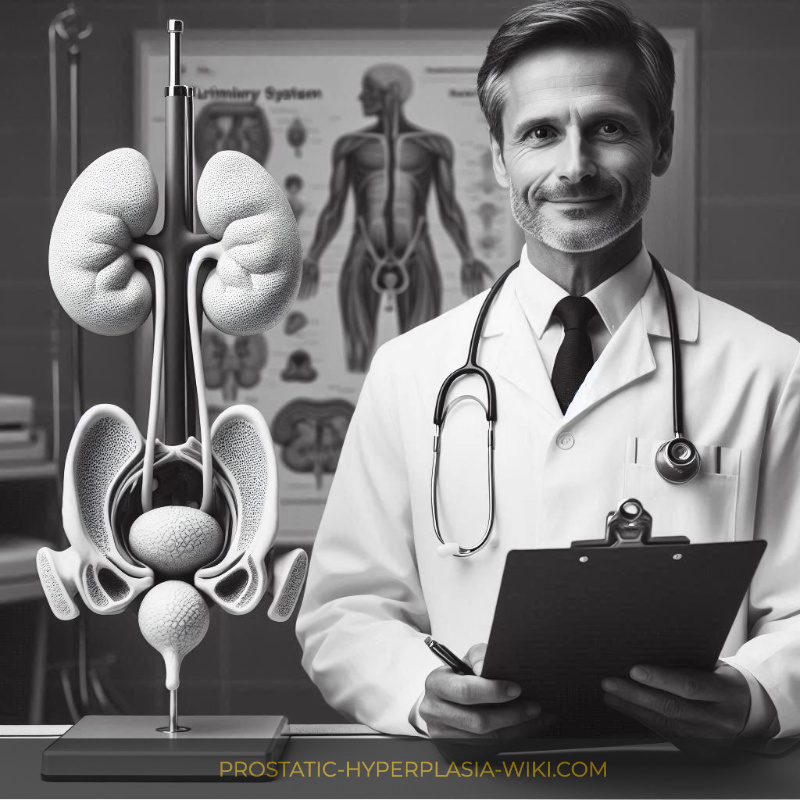Understanding Prostatic Hyperplasia: a Primer
Benign Prostatic Hyperplasia (BPH), commonly known as prostate gland enlargement, is a prevalent condition affecting men, especially as they advance in age. This noncancerous enlargement of the prostate can impair the flow of urine out of the bladder, leading to urinary symptoms that significantly affect a man's quality of life. The exact etiology of BPH remains an area of active research, yet factors like aging, hormonal changes, and genetic predispositions are thought to play critical roles. Understanding the physiological changes that the prostate undergoes during BPH is essential for grasping the complexity of this condition.
The prostate is a walnut-sized gland situated just below the bladder, surrounding the urethra - the duct responsible for carrying urine from the bladder out of the body. In BPH, the prostate gland enlarges, pressing against and narrowing the urethra, causing a variety of urinary symptoms. These can range from increased urinary frequency, nocturia (nighttime urination), difficulty starting urination, weak urine stream to incomplete bladder emptying. The severity of symptoms varies, but they tend to gradually worsen over time if left unaddressed.
| Aspect | Description |
|---|---|
| Condition | Benign Prostatic Hyperplasia (BPH) |
| Etiology | Aging, hormonal changes, genetic predispositions |
| Common Symptoms | Increased urinary frequency, nocturia, difficulty starting urination, weak urine stream |
| Diagnostic Tools | Medical history, physical exam, PSA test, ultrasound, IPSS questionnaire |
The diagnosis of BPH involves a comprehensive evaluation, including a detailed medical history, physical examination, and specific tests such as the Prostate-Specific Antigen (PSA) test and ultrasound. The PSA test is particularly notable for its role in ruling out prostate cancer, which can present with similar symptoms. A critical aspect of diagnosing BPH is the use of the International Prostate Symptom Score (IPSS), a questionnaire designed to assess the severity of urinary symptoms and their impact on daily life.
Furthermore, understanding the potential complications of untreated BPH is paramount. These may include urinary tract infections, bladder stones, and chronic kidney disease. Given these possible outcomes, early detection and management are crucial in preserving urinary health and preventing the progression of symptoms.
Diet Modifications for Managing Symptoms
Prostatic hyperplasia, a condition marked by the enlargement of the prostate gland, poses significant challenges to those affected, influencing urinary functions and overall quality of life. The cornerstone in managing its symptoms effectively includes dietary modifications, necessitating a profound understanding of how certain foods and nutrients impact the prostate's health. A diet rich in fruits, vegetables, and whole grains, while low in red meats and high-fat dairy products, has been identified to potentially alleviate symptoms. The incorporation of omega-3 fatty acids, found abundantly in fish like salmon and sardines, plays a crucial role in reducing inflammation, a key factor in prostatic conditions.

Emerging evidence suggests that foods high in antioxidants, such as tomatoes rich in lycopene, and green tea, known for its catechins, could offer protective benefits against prostatic hyperplasia. These dietary elements not only aim at symptom management but also contribute to reducing the risk of progression. It is the specificity of these nutrients, their roles in cellular health, and their anti-inflammatory properties that underpin their importance in a dietary strategy designed for prostatic health. Moreover, limiting the intake of caffeine and alcohol, substances that can exacerbate urinary symptoms, forms an essential part of dietary advice for individuals navigating life with prostatic hyperplasia.
The role of dietary modifications extends beyond mere symptom management; it encompasses a broader strategy aimed at enhancing overall well-being. Consuming a balanced diet ensures adequate intake of essential nutrients, which in turn supports the body's natural defense mechanisms. Such a diet, when tailored to address the unique challenges posed by prostatic hyperplasia, empowers individuals to maintain an active, healthier lifestyle despite the condition's constraints.
In this light, understanding what prostatic hyperplasia entails and how dietary choices influence symptom manifestation and management becomes paramount. As research continues to uncover the complex interplay between diet and prostatic health, individuals afflicted with prostatic hyperplasia are equipped with actionable insights. These insights not only guide them in making informed dietary choices but also in adopting a proactive stance toward managing their condition, highlighting the vital role of nutrition in navigating the challenges posed by prostatic hyperplasia.
Exercise Approaches Tailored for Prostatic Health
Understanding the intricate balance of lifestyle modifications necessary for managing prostatic hyperplasia can significantly enhance one’s quality of life. Among the arsenal of non-pharmacological approaches, physical activity emerges as a cornerstone for mitigating symptoms associated with this condition. Scientific evidence underscores the utility of specific exercises in ameliorating lower urinary tract symptoms (LUTS), which are often exacerbated by prostatic enlargement. Pelvic floor muscle exercises, popularly known as Kegel exercises, have shown promise in improving the control over urination by strengthening the muscles around the bladder and prostate. These exercises, when performed regularly, can potentially reduce the urgency and frequency of urination, two of the most common complaints among those with prostatic hyperplasia. 
Delving further into the exercise spectrum, aerobic workouts, such as walking, swimming, and cycling, have also been associated with a reduction in LUTS severity. Regular participation in mild to moderate intensity aerobic activities can enhance blood flow and promote overall prostate health, thereby mitigating the discomfort associated with prostatic hyperplasia. It's crucial, however, to tailor exercise intensity to individual fitness levels and medical history, to avoid exacerbating the condition. The nuanced approach to exercising allows individuals to reap the benefits of physical activity without placing undue stress on the body.
Moreover, the interplay between reduced sedentary behavior and improved prostatic health cannot be overstated. Prolonged periods of sitting have been linked to an increased risk of developing more severe urinary symptoms. Thus, incorporating standing desks, short frequent walks, and stretch breaks during long sitting periods can contribute to symptom management. These minor lifestyle adjustments can forge a significant impact on daily comfort and symptom management.
Lastly, it is imperative to consult healthcare professionals prior to embarking on a new exercise regime. This dialogue ensures that the chosen activities align with the patient's physical capacity and health objectives, fostering a synergistic approach towards managing what is prostatic hyperplasia. Engaging in informed discussions about exercise modifications can pave the way for a holistic treatment strategy, seamlessly integrating with medical or surgical interventions. Through a concerted effort emphasizing targeted physical activities, individuals can navigate the challenges of prostatic hyperplasia with optimism and resilience.
The Role of Regular Medical Check-ups
Regular medical evaluations play a pivotal role in managing the condition known as prostatic hyperplasia, a common ailment characterized by an enlargement of the prostate gland that often leads to discomfort and various urinary symptoms. These check-ups offer a platform for healthcare providers to monitor the progression of the disease, adjusting treatment plans as necessary to optimize patient outcomes. During these consultations, physicians can employ various diagnostic tools, such as prostate-specific antigen (PSA) tests and digital rectal exams (DRE), to assess the condition’s evolution and its impact on the patient's health. Such personalized assessments are crucial for catching potential complications early and implementing preventive measures or interventions that may halt or reverse symptom progression. 
In the context of prostatic hyperplasia management, the frequency and nature of medical appointments can significantly influence the effectiveness of the chosen therapeutic strategies. Through regular interaction with their healthcare team, patients are afforded the opportunity to report new symptoms, discuss the side effects of medications, and gain insights into novel treatment options, including advancements in pharmacological and surgical interventions. This continuous dialogue ensures that any adjustments to the management plan are made with a thorough understanding of the patient’s current health status, lifestyle factors, and treatment preferences. Thus, the dynamic nature of these check-ups facilitates a more responsive and tailored approach to managing prostatic hyperplasia, enhancing the patient's quality of life and potentially reducing the risk of acute complications such as urinary retention.
Moreover, these systematic evaluations can serve as an educational nexus for patients, empowering them with knowledge about their condition and fostering a proactive attitude towards self-care. Healthcare professionals can offer valuable advice on lifestyle modifications, such as dietary changes and exercise regimens, that complement medical treatments and support overall well-being. Ultimately, the consistent engagement with the medical system encourages a holistic view of health management where the patient and healthcare provider collaborate closely to navigate the challenges of prostatic hyperplasia. This partnership is instrumental in achieving optimal control over symptoms and maintaining a high quality of life despite the condition's persistence.
Stress Management Techniques for Overall Well-being
Managing the psychological effects of health conditions is as paramount as addressing the physical ones, especially in the context of prostatic hyperplasia. Stress, a common precipitant of symptom exacerbation, can significantly impair one's quality of life, making the management of this condition more challenging. Implementing effective stress reduction methods is crucial for enhancing patient well-being and optimizing overall health outcomes. Techniques such as mindfulness meditation, deep breathing exercises, and progressive muscle relaxation have demonstrated efficacy in mitigating stress levels, contributing to a more balanced and healthier life.
Furthermore, the integration of cognitive behavioral therapy (CBT) serves as a powerful tool in managing stress, providing individuals with strategies to alter negative thought patterns that may exacerbate symptoms of prostatic hyperplasia. Engaging in regular physical activity, although tailored to not aggravate symptoms, further aids in stress reduction, promoting both emotional and physiological resilience. Establishing a supportive network, whether through family, friends, or support groups specifically for those with prostatic hyperplasia, can also provide emotional scaffolding, crucial for navigating the challenges posed by this condition.
The role of a balanced diet in stress management should not be underestimated. Consuming a diet rich in antioxidants and anti-inflammatory foods can combat oxidative stress, contributing to a reduction in prostatic inflammation and an overall sense of well-being. Hydration is equally important, with an emphasis on reducing caffeine and alcohol intake, which may exacerbate symptoms.
In summary, a holistic approach, encompassing physiological, psychological, and social interventions, is instrumental for managing stress effectively in those with prostatic hyperplasia. The table below outlines key strategies and their impact:
| Strategy | Description | Impact |
|---|---|---|
| Mindfulness Meditation | Practicing present-moment awareness and acceptance. | Reduces stress and improves emotional regulation. |
| Cognitive Behavioral Therapy | Identifying and altering negative thought patterns. | Enhances coping skills, reducing stress and anxiety. |
| Exercise | Tailored physical activities maintaining general health. | Decreases stress hormones and improves mood. |
| Dietary Modifications | Anti-inflammatory and antioxidant-rich foods. | Reduces oxidative stress, promoting overall well-being. |
Adopting these strategies not only aids in dealing with the physical symptoms of prostatic hyperplasia but also in achieving a state of comprehensive wellness.
Exploring Medication and Surgical Options Wisely
The journey through managing prostatic hyperplasia often leads one to consider medication and surgical interventions alongside lifestyle modifications. Understanding the pharmacological landscape is crucial, as medications like alpha-blockers and 5-alpha-reductase inhibitors play a pivotal role in alleviating urinary symptoms by relaxing bladder neck muscles and shrinking the prostate, respectively. However, the intricacies of these drugs, including their side effects and contraindications, necessitate a nuanced approach, underpinning the importance of medical guidance in selecting the most appropriate therapeutic option.

In more advanced cases, where medication provides insufficient relief, surgical options may become a consideration. Techniques such as Transurethral Resection of the Prostate (TURP) have stood the test of time, offering significant symptom relief. Yet, the evolution of medical technology has ushered in minimally invasive surgical options like laser therapy, which promise effective outcomes with reduced complications. Each surgical modality carries its own set of advantages and potential risks, emphasizing the need for a comprehensive evaluation of patient-specific factors prior to proceeding.
Delving deeper into the decision-making process, it becomes apparent that a tailored approach, which balances the severity of symptoms with individual health profiles and preferences, is imperative. For instance, while some may prioritize the immediacy of symptom relief through surgical means, others may have a higher tolerance for symptoms and opt for a conservative medication regimen. This decision-making calculus is further complicated by the potential long-term implications on quality of life, such as erectile dysfunction and urinary incontinence, which underscore the significance of thoughtful consideration and dialogue with healthcare providers.
Amidst navigating these therapeutic pathways, the overarching narrative emphasizes a proactive engagement with healthcare practitioners. By fostering an informed and collaborative relationship, individuals can navigate the complexities of medication and surgical interventions wisely, ensuring that the chosen treatment aligns with their health objectives and lifestyle aspirations, thereby enhancing their quality of life in the face of prostatic hyperplasia.
Content Manager: Dr. Eric Klein











